The Conquest of Illusion:
Is What We See Real?
Among the valuable insights that van der Leeuw spelled out in the book, his second-chapter analysis of how we see stands out to me as one of the most provocative. He leads the reader step by step, in a simple yet complete fashion, to the inevitable mystery of sense perception – and to what can profitably be a "doubt sensation" about the relation of our perceptions to reality. He illustrates his analysis with a series of plates which I've included on this page along with some summary comments.
JJ van der Leeuw published "The Conquest of Illusion" in 1928, with a dedication to J. Krishnamurti and in memory of Krishnamurti's brother Nityananda. Richard Rose, who had a profound self-realization experience in 1947 at the age of 30, came across the book in the late 1950s, when it was recommended to him by a cab driver in Los Angeles who also told him about Alfred Pulyan. Rose recommended the book to his students, along with books by Hartmann, Santanelli, Ouspensky, Merrell-Wolff, Brunton and others.
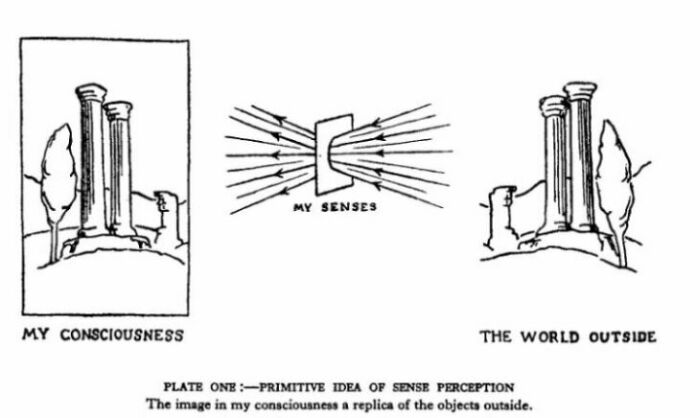
In the first plate, van der Leeuw depicts the conventional understanding of an external world that we perceive accurately. In other words, our consciousness presents us with an exact replica of the outside world. He titles this a primitive idea of sense perception, so he obviously has an explanation in store that he considers less primitive.
He begins the exploration by going into the physiology of sense perception, particularly the sense of sight. The physiologist tells us that light rays are reflected off objects in the outside world, creating vibrations that hit the rods and cones in the eye. That in turn causes chemical and electric changes to be transmitted along the optic nerves to the brain. And somewhere in our consciousness, an image forms, as depicted in plate two:
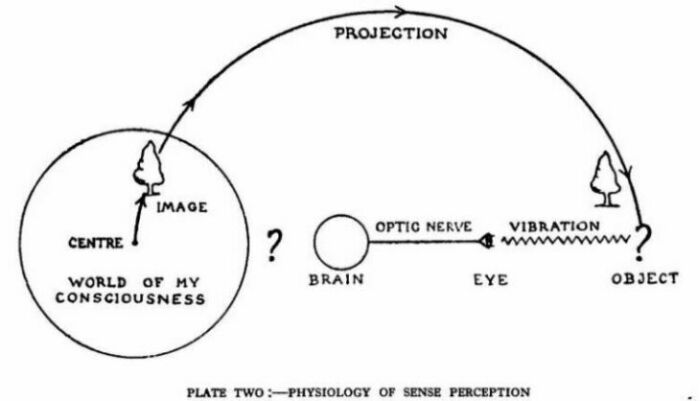
If we scrutinized the brain with our sense perception, or with equipment designed to enhance that capability, we would detect chemical and electrical changes – but nowhere would be find an image with color, shape, texture, etc. And that is the great mystery of sense perception. The image that we "see" depends on our interpretation of cellular changes. Van der Leeuw points out that, for all we know, what triggered the image may be "a mathematical point, having within itself certain properties which, reacting on a human consciousness, produce there the different qualities which make up the image ... as we see it."
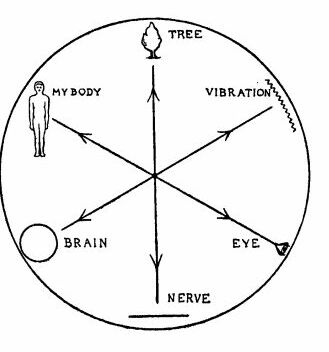 And there is another function in addition to interpretation that we're adding to the process: "We think we are perceiving as an objective reality that which we are projecting as an image in the world of our consciousness." Every image that we see in our consciousness we project outside ourselves and pretend that we're seeing that image outside.
And there is another function in addition to interpretation that we're adding to the process: "We think we are perceiving as an objective reality that which we are projecting as an image in the world of our consciousness." Every image that we see in our consciousness we project outside ourselves and pretend that we're seeing that image outside.
In plate three, The World of My Consciousness, van der Leeuw "complicates" the picture a bit by reminding us that we know the vibrations, the body, the eye, the optic nerve, and the brain by this same process of sense perception as we know a cat or a tree. And everything we know by sense perception is in the world that we're questioning – the world of the unknown. The relation of the image that we see to what actually triggers the perception (and projection) is unknown.
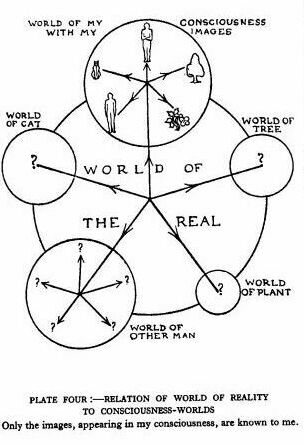 The world we see around us is, in fact, an image arising in our consciousness. But if we compare notes with our fellow-beings, we find that there is a great similarity of interpretation between the tree we see and that our neighbors see. There must be a common source providing the stimulus that produces these compatible images in ourselves and our neighbors. Van der Leeuw terms this source the world of the real, and in the fourth plate he addresses the question of the relationship of the world of the real to the individual consciousness worlds.
The world we see around us is, in fact, an image arising in our consciousness. But if we compare notes with our fellow-beings, we find that there is a great similarity of interpretation between the tree we see and that our neighbors see. There must be a common source providing the stimulus that produces these compatible images in ourselves and our neighbors. Van der Leeuw terms this source the world of the real, and in the fourth plate he addresses the question of the relationship of the world of the real to the individual consciousness worlds.
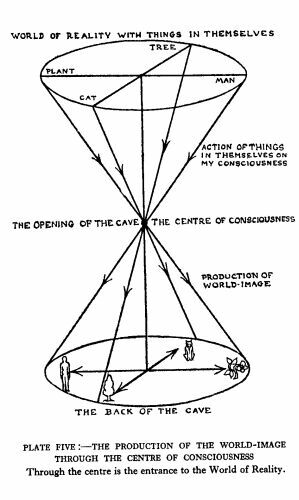 But where is this world of the real? Using the allegory of the cave from Plato's Republic, van der Leeuw illustrates in plate five how the production of our world image is projected through an opening in the center of our consciousness. "Instead of being aware that they act on us from within," however, "we gaze upon the image ... and wonder how it influences us from without."
But where is this world of the real? Using the allegory of the cave from Plato's Republic, van der Leeuw illustrates in plate five how the production of our world image is projected through an opening in the center of our consciousness. "Instead of being aware that they act on us from within," however, "we gaze upon the image ... and wonder how it influences us from without."
The teaching of self-realized men throughout history has centered around their personal testimony that it's possible to follow the ray of projection back to its source, to the world of the real. And by transcending our identification with the world of individual consciousness, we find the solution to the problem of life. When we enter the world of the real, we return to our real home, simultaneously finding our true identity and the answer to all the questions of life and death.

You can find a new or used copy of The Conquest of Illusion on Amazon.
In addition to Amazon.com,
Half.com
and BookFinder.com are good sources of new and used books.

RECENT EXPERIMENTAL EVIDENCE
By Rupert Sheldrake, Ph.D.
"Where are our minds located? We have been brought up to believe that they are inside our heads, that mental activity is nothing but brain activity. Instead, I suggest that our minds extend far beyond our brains; they stretch out through fields that link us to our environment and to each other.
"Mental fields are rooted in brains, just as magnetic fields around magnets are rooted in the magnets themselves, or just as the fields of transmission around mobile phones are rooted in the phones and their internal electrical activities. As magnetic fields extend around magnets, and electromagnetic fields around mobile phones, so mental fields extend around brains.
"Mental fields help to explain telepathy, the sense of being stared at and other widespread but unexplained abilities. Above all, mental fields underlie normal perception. They are an essential part of vision.
IMAGES OUTSIDE OUR HEADS
"Look around you now. Are the images of what you see inside your brain? Or are they outside you – just where they seem to be?
"According to the conventional theory, there is a one-way process: light moves in, but nothing is projected out. The inward movement of light is familiar enough. As you look at this page, reflected light moves from the page through the electromagnetic field into your eyes. The lenses of your eyes focus the light to form upside-down images on your retinas. This light falling on your retinal rod and cone cells causes electrical changes within them, which trigger off patterned changes in the nerves of the retina. Nerve impulses move up your optic nerves and into the brain, where they give rise to complex patterns of electrical and chemical activity. So far, so good. All these processes can be, and have been, studied in great detail by neurophysiologists and other experts on vision and brain activity.
"But then something very mysterious happens. You consciously experience what you are seeing, the page in front of you. You also become conscious of the printed words and their meanings. From the point of view of the standard theory, there is no reason why you should be conscious at all. Brain mechanisms ought to go on just as well without consciousness.
"Then comes a further problem. When you see this page, you do not experience your image of it as being inside your brain, where it is supposed to be. Instead, you experience its image as being located about two feet in front of you. The image is outside your body.
"For all its physiological sophistication, the standard theory has no explanation for your most immediate and direct experience. All your experience is supposed to be inside your brain, a kind of virtual reality show inside your head. That means your skull must lie beyond everything you are seeing: if you look at the sky, your skull must be beyond the sky! This seems an absurd idea, but it seems to be a necessary implication of the mind-in-brain theory.
"The idea I am proposing is so simple that it is hard to grasp. Your image of this page is just where it seems to be, in front of your eyes, not behind your eyes. It is not inside your brain, but outside your brain.
"Thus vision involves both an inward movement of light, and an outward projection of images. Through mental fields our minds reach out to touch what we are looking at. If we look at a mountain ten miles away, our minds stretch out ten miles. If we gaze at distant stars our minds reach out into the heavens, over literally astronomical distances.
THE SENSE OF BEING STARED AT
"Sometimes when I look at someone from behind, he or she turns and looks straight at me. And sometimes I suddenly turn around and find someone staring at me. Surveys show that more than 90% of people have had experiences such as these. The sense of being stared at should not occur if attention is all inside the head. But if it stretches out and links us to what we are looking at, then our looking could affect what we look at. Is it just an illusion, or does the sense of being stared at really exist?
"This question can be explored through simple, inexpensive experiments. People work in pairs. One person, the subject, sits with his or her back to the other, wearing a blind-fold. The other person, the looker, sits behind the subject, and in a random series of trials either looks at the subject's neck, or looks away and think of something else. The beginning of each trial is signalled by a mechanical clicker or bleeper. Each trial lasts about ten seconds and the subject guesses out loud "looking" or "not looking". Detailed instructions are given on my website, www.sheldrake.org. More than 100,000 trials have now been carried out, and the results are overwhelmingly positive and hugely significant statistically, with odds against chance of quadrillions to one. The sense of being stared at even works when people are looked at through closed-circuit TV. Animals are also sensitive to being looked at by people, and people by animals. This sensitivity to looks seems widespread in the animal kingdom and may well have evolved in the context of predator-prey relationships: an animal that sensed when an unseen predator was staring would stand a better chance of surviving than an animal without this sense.
TELEPATHY
"Educated people have been brought up to believe that telepathy does not exist. Like other so-called psychic phenomena, it is dismissed as an illusion.
"Most people who espouse these opinions, which I used to myself, do not do so on the basis of a close examination of the evidence. They do so because there is a taboo against taking telepathy seriously. This taboo is related to the prevailing paradigm or model of reality within institutional science, namely the mind-inside-the-brain theory, according to which telepathy and other psychic phenomena, which seem to imply mysterious kinds of 'action at a distance', cannot possibly exist.
"This taboo dates back at least as far as the Enlightenment at the end of the eighteenth century. But this is not the place to examine its history (which I discuss in The Sense of Being Stared At). Rather I want to summarize some recent experiments, which suggest that telepathy not only exists, but that it is a normal part of animal communication.
PSYCHIC PETS
"I first became interested in the subject of telepathy some fifteen years ago, and started looking at evidence for telepathy in the animals we know best, namely pets. I soon came across numerous stories from owners of dogs, cats, parrots, horses and other animals that suggested that these animals seemed able to read their minds and intentions.
"Through public appeals I have built up a large database of such stories, currently containing more than 5,000 case histories. These stories fall into several categories. For example, many cat owners say that their animals seem to sense when they are planning to take them to the vet, even before they have taken out the carrying basket or given any apparent clue as to their intention. Some people say their dogs know when they are going to be taken for a walk, even when they are in a different room, out of sight or hearing, and when the person is merely thinking about taking them for a walk. Of course, no one finds this behaviour surprising if it happens at a routine time, or if the dogs see the person getting ready to go out, or hear the word "walk". They think it is telepathic because it seems to happen in the absence of such clues.
"One of the commonest and most testable claims about dogs and cats is that they know when their owners are coming home, in some cases anticipating their arrival by ten minutes or more. In random household surveys in Britain and America, my colleagues and I have found that approximately 50% of dog owners and 30% of cat owners believe that their animals anticipate the arrival of a member of the household. Through hundreds of videotaped experiments, my colleagues and I have shown that dogs react to their owners' intentions to come home even when they are many miles away, even when they return at randomly-chosen times, and even when they travel in unfamiliar vehicles such as taxis. Telepathy seems the only hypothesis that can account for the facts. (For more details, see my book Dogs that Know When their Owners Are Coming Home, And Other Unexplained Powers of Animals.)
TELEPHONE TELEPATHY
"In the course of my research on unexplained powers of animals, I heard of dozens of dogs and cats that seemed to anticipate telephone calls from their owners. For example, when the telephone rings in the household of a noted professor at the University of California at Berkeley, his wife knows when her husband is on the other end of the line because Whiskins, their silver tabby cat, rushes to the telephone and paws at the receiver. "Many times he succeeds in taking it off the hook and makes appreciative miaws that are clearly audible to my husband at the other end", she says. "If someone else telephones, Whiskins takes no notice." The cat responds even when he telephones home from field trips in Africa or South America.
"This led me to reflect that I myself had had this kind of experience, in that I had thought of people for no apparent reason who, shortly thereafter, called. I asked my family and friends if they had ever had this experience, and I soon found the majority were very familiar with it. Some said they knew when their mother or boyfriend or other significant person was calling because the phone sounded different!
"Through extensive surveys, my colleagues and I have found that the most people have had seemingly telepathic experiences with telephone calls. Indeed this is the commonest kind of apparent telepathy in the modern world.
"Is this all a matter of coincidence, and selective memory, whereby people only remember when someone they were thinking about rang, and forget all the times they were wrong? Most sceptics assume that this is the case, but until recently there had never been any scientific research on the subject at all.
"I have developed a simple experiment to test for telephone telepathy. Participants receive a call from one of four different callers at a prearranged time, and they themselves choose the callers, usually close friends or family members. For each test, the caller is picked at random by the experimenter by throwing a die. The participant has to say who the caller is before the caller says anything. If people were just guessing, they would be right about one time in four, or 25% of the time.
"We have so far conducted more than 800 such trials, and the average success rate is 42%, very significantly above the chance level of 25%, with astronomical odds against chance (1026 to 1).
"We have also carried out a series of trials in which two of the four callers were familiar, while the other two were strangers, whose names the participants knew, but whom they had not met. With familiar callers, the success rate was 56 %, highly significant statistically. With strangers it was at the chance level, in agreement with the observation that telepathy typically takes place between people who share emotional or social bonds.
"In addition, we have found that these effects do not fall off with distance. Some of our participants were from Australia or New Zealand, and they could identify who was calling just as well as with people down under as with people only a few miles away.
EXTENDED MINDS
"Laboratory studies by parapsychologists have already provided significant statistical evidence for telepathy (well reviewed by Dean Radin in his book The Conscious Universe, Harper, San Francisco, 1997). But most laboratory research has given rather weak effects, probably because most participants and "senders" were strangers to each other, and telepathy normally depends on social bonds.
"The results of telephone telepathy experiments give much stronger and more repeatable effects because they involve people who know each other well. I have also found that there are striking telepathic links between nursing mothers and their babies. Likewise, the telepathic reactions of pets to their owners depend on strong social bonds.
"I suggest that these bonds are aspects of the fields that link together members of social groups (which I call morphic fields) and which act as channels for the transfer of information between separated members of the group. Telepathy literally means "distant feeling", and typically involves the communication of needs, intentions and distress. Sometimes the telepathic reactions are experienced as feelings, sometimes as visions or the hearing of voices, and sometimes in dreams. Many people and pets have reacted when people they are bonded to have had an accident, or are dying, even if this is happening many miles away.
"There is an analogy for this process in quantum physics: if two particles have been part of the same quantum system and are separated in space, they retain a mysterious connectedness. When Einstein first realized this implication of quantum theory, he thought quantum theory must be wrong because it implied what he called a "spooky action at a distance". Experiments have shown that quantum theory is right and Einstein wrong. A change in one separated part of a system can affect another instantaneously. This phenomenon is known as quantum non-locality or non-separability.
"Telepathy, like the sense of being stared at, is only paranormal if we define as "normal" the theory that the mind is confined to the brain. But if our minds reach out beyond our brains, just as they seem to, and connect with other minds, just as they seem to, then phenomena like telepathy and the sense of being stared at seem normal. They are not spooky and weird, on the margins of abnormal human psychology, but are part of our biological nature.
"Of course, I am not saying that the brain is irrelevant to our understanding of the mind. It is very relevant, and recent advances in brain research have much to tell us. Our minds are centred in our bodies, and in our brains in particular. However, that they are not confined to our brains, but extend beyond them. This extension occurs through the fields of the mind, or mental fields, which exist both within and beyond our brains.
"The idea of the extended mind makes better sense of our experience than the mind-in-brain theory. Above all, it liberates us. We are no longer imprisoned within the narrow compass of our skulls, our minds separated and isolated from each other. We are no longer alienated from our bodies, from our environment and from other people. We are interconnected."

© Rupert Sheldrake 2006. Dr. Sheldrake is a biologist and author of The Sense of Being Stared at, and Other Aspects of the Extended Mind. He is a Fellow of the Institute of Noetic Sciences, near San Francisco, and Director of the Perrott-Warrick Research Project, funded by Trinity College, Cambridge. He lives in London with his wife, Jill Purce, and their two sons. His web site is www.sheldrake.org. The above synopsis is from a talk given by Sheldrake at the September 2006 "Just For The health Of It" Prophets Conference in Vancouver, Canada.
Science and Spiritual Practices and other Sheldrake books are available on Amazon, Powells.com and Alibris.com.

SCIENTIFIC EXPLANATION OF PERCEPTION
By Douglas E. Harding
"All this, however clearly given in first-hand experience [i.e., the fact that from the first-person vs. the third-person point of view the seer has no head - Ed.] appears nevertheless wildly paradoxical, an affront to common-sense. It is also an affront to science, which is said to be only common-sense tidied up somewhat? Anyhow, the scientist has his own story of how I see some things (such as your head) but not others (such as my head): and obviously his story works. The question is: can he put my head [which I see only in a mirror or other reflective surface - Ed.] back on my shoulders, where people tell me it belongs?
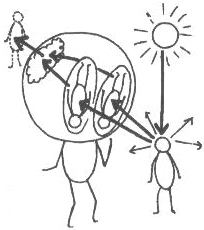 "At its briefest and plainest, his tale of how I see you runs something like this. Light leaves the sun, and eight minutes later gets to your body, which absorbs part of it. The rest bounces off in all directions, and some of it reaches my eye, passing through the lens and forming an inverted picture of you on the screen at the back of my eyeball. This picture sets up chemical changes in a light-sensitive substance there, and these changes disturb the cells (they are tiny living creatures) of which the screen is built. They pass on their agitation to other, very elongated cells; and these, in turn, to cells in a certain region of my brain. It is only when this terminus is reached, and the molecules and atoms and particles of these brain-cells are affected, that I see you or anything else. And the same is true of the other senses; I neither see nor hear nor smell nor taste nor feel anything at all until the converging stimuli actually arrive, after the most drastic changes and delays, at this centre. It is only at this terminus, this moment and place of all arrivals at the Grand Central Station of my Here-Now, that the whole traffic system – what I call my universe – springs into existence. For me, this is the time and place of all creation.
"At its briefest and plainest, his tale of how I see you runs something like this. Light leaves the sun, and eight minutes later gets to your body, which absorbs part of it. The rest bounces off in all directions, and some of it reaches my eye, passing through the lens and forming an inverted picture of you on the screen at the back of my eyeball. This picture sets up chemical changes in a light-sensitive substance there, and these changes disturb the cells (they are tiny living creatures) of which the screen is built. They pass on their agitation to other, very elongated cells; and these, in turn, to cells in a certain region of my brain. It is only when this terminus is reached, and the molecules and atoms and particles of these brain-cells are affected, that I see you or anything else. And the same is true of the other senses; I neither see nor hear nor smell nor taste nor feel anything at all until the converging stimuli actually arrive, after the most drastic changes and delays, at this centre. It is only at this terminus, this moment and place of all arrivals at the Grand Central Station of my Here-Now, that the whole traffic system – what I call my universe – springs into existence. For me, this is the time and place of all creation.
"There are many odd things, infinitely remote from common-sense, about this plain tale of science. And the oddest of them is that the tale's conclusion cancels out the rest of it. For it says that all I can know is what is going on here and now, at this brain terminal, where my world is miraculously created. I have no way of finding out what is going on elsewhere – in the other regions of my head, in my eyes, in the outside world – if, indeed, there is an elsewhere, an outside world at all. The sober truth is that my body, and your body, and everything else on Earth, and the Universe itself – as they might exist out there in themselves and in their own space, independently of me – are mere figments, not worth a second thought. There neither is nor can be any evidence for two parallel worlds (an unknown outer or physical world there, plus a known inner or mental world here which mysteriously duplicates it) but only for this one world which is always before me, and in which I can find no division into mind and matter, inside and outside, soul and body. It is what it's observed to be, no more and no less, and it's the explosion of this centre – this terminal spot where "I" or "my consciousness" is supposed to be located – an explosion powerful enough to fill out and become this boundless scene that's now before me, that is me.
"In brief, the scientist's story of perception, so far from contradicting my naïve story, only confirms it. Provisionally and common-sensibly, he put a head here on my shoulders, but it was soon ousted by the universe. The common-sense or unparadoxical view of myself as an "ordinary man with a head" doesn't work at all; as soon as I examine it with any care, it turns out to be nonsense."

From On Having No Head: Zen and the Rediscovery of the Obvious by Douglas E. Harding. The first half of this book was published in the 1960s and became a worldwide classic. At age 77 Harding had, in my opinion, a final breakthrough and added "Bringing the Story Up to Date: The Eight Stages of the Headless Way." See the Greatest Teachers section of this site for more on Harding's life and teaching.

From Proust Was a Neuroscientist, by Jonah Lehrer
Jonah Lehrer, a Columbia U. graduate and a Rhodes scholar, worked in the lab of Nobel Prize-winning neuroscientist Eric Kandel and in the kitchens of Le Cirque 2000 and Le Bernadin. His book is a fascinating study of eight artists including a painter (Cézanne), a poet, a chef, a composer, and several novelists – showing how "each one discovered an essential truth about the mind that science is only now rediscovering." In the case of Cézanne, it was about human vision.
"Understanding how sight starts, how the eyeball transforms light into an electrical code, is one of the most satisfying discoveries of modern neuroscience. No other sense has been so dissected. We now know that vision begins with an atomic disturbance. Particles of light alter the delicate molecular structure of the receptors in the retina. This cellular shudder triggers a chain reaction that ends with a flash of voltage. The photon's energy has become information.[1]
"What happens during this blink of unconscious activity? The first scientific glimpse into how the brain processes the eye's data arrived in the late 1950s, in an astonishing set of experiments by David Hubel and Torsten Weisel....
"Before Hubel and Weisel, scientists assumed that the eye was like a camera, and that the brain's visual field was composed of dots of light, neatly arranged in time and space. Just as a photograph was made up of a quilt of pixels, so must the eye create a two-dimensional representation of reflected light that it seamlessly transmitted to the brain. Yet when scientists tried finding this camera inside the skull, all they found was silence, the electrical stupor of uninterested cells.
"This was a frustrating paradox. The animal clearly could see, and yet its cells, when isolated with a beam of light, were quiet. It was as if the animal's vision was emerging from a blank canvas. Hubel and Weisel bravely ventured into this mystery. At first, their results only confirmed the impossibility of activating cortical neurons with individual pricks of light. But then, by complete accident, they discovered an excited cell, a neuron interested in the slice of world it had seen.
"What was this cell responding to? Hubel and Weisel had no idea. The neuron became active at the exact moment it was supposed to be silent, when they were in between experiments. There was no light to excite it. Only after retracing their exact steps did Hubel and Weisel figure out what had happened. As they had inserted a glass slide into the light projector, they had inadvertently cast "a faint but sharp shadow" onto the cat's retina. It was just a fleeting glint of brightness – a straight line pointed in a single direction – but it was exactly what the cell wanted.
"Hubel and Weisel were stunned by their discovery. They had glimpsed the raw material of vision, and it was completely abstract. Our brain cells were strange things, fascinated not by dots of light but by angles of lines.[2]
These neurons preferred contrast over brightness, edges over curves....
"Cézanne's paintings echo this secret geometry of lines sensed by the visual cortex. It's as if he broke the brain apart and saw how seeing occurs....
"At the literal level of paint, Cézanne represented the landscape as nothing but a quilt of brushstrokes, each one a separate line of color ... creating the entire picture out of patches and strokes, les tâches and les touches....
"Neuroscientists now know that what we end up seeing is highly influenced by something called top-down processing, a term that describes the way cortical brain layers project down and influence (corrupt, some might say) our actual sensations. After the inputs of the eye enter the brain, they are immediately sent along two separate pathways, one of which is fast and one of which is slow. The fast pathway quickly transmits a coarse and blurry picture to our prefrontal cortex, a brain region involved in conscious thought. Meanwhile, the slow pathway takes a meandering route through the visual cortex, which begins meticulously analyzing and refining the lines of light. The slow image arrives in the prefrontal cortex about fifty milliseconds after the fast image.
"Why does the mind see everything twice? Because our visual cortex needs help. After the prefrontal cortex receives its imprecise picture, the "top" of the brain quickly decides what the "bottom" has seen and begins doctoring the sensory data....
"As Cézanne aged, his paintings became filled by more and more naked canvas, what he eloquently called nonfinito. No one had ever done this before. The painting was clearly incomplete. How could it be art? But Cézanne was unfazed by his critics. He knew that his paintings were only literally blank.[3]
"For example, look at Cézanne's watercolors of Mont Sainte-Victoire. In his final years, Cézanne walked every morning to the crest of Les Lauves, where an expansive view of the Provençal plains opened up before him. He would paint in the shade of a linden tree. From there, Cézanne said, he could see the land's hidden patterns, the way the river and vineyards were arranged in overlapping planes. In the background was always the mountain, that jagged isosceles of rock that seemed to connect the dry land with the infinite sky....
"And yet the mountain does not disappear. It is there, an implacable and adamant presence. The mind easily invents the form that Cézanne's paint barely insinuates. Although the mountain is almost literally invisible – Cézanne has only implied its presence – its looming gravity anchors the painting. We don't know where the painting ends and we begin....
"When Cézanne began his studies in the blank canvas, science had no way of explaining why the paintings appeared less vacant than they actually were. The very existence of Cézanne's nonfinito style, the fact that the brain could find meaning in nothing, seemed to disprove any theory of mind that reduced our vision to pixels of light.
"The Gestalt psychologists of the early twentieth century were the first scientists to confront the illusions of form that Cézanne so eloquently manipulated....
"... The Gestaltists set out to prove that the process of seeing alters the world we observe. Like Immanuel Kant, their philosophical precursor, they argued that much of what was thought of as being out there – in our sensations of the outside world – actually came from in here, from inside the mind. ("The imagination" Kant wrote, "is a necessary ingredient of perception itself.") As evidence for their theories of perception, the Gestaltists used optical illusions. These ranged from the illusion of apparent motion in a movie (the film is really a set of static photographs flipped twenty-four times a second) to drawings that seem to oscillate between two different forms (the classic example is the vase that can also be seen as two faces in silhouette). According to the Gestaltists, these everyday illusions were proof that everything we saw was an illusion. Form is dictated from the top down. Unlike the Wundtians [reductionists, who argued that visual perception is ultimately reducible to its elemental sensations - Ed.], who began with our sensory fragments, the Gestaltists began with reality as we actually experienced it.
"Modern neuroscientific studies of the visual cortex have confirmed the intuitions of Cézanne and the Gestaltists: visual experience transcends visual sensations.... If the mind didn't impose itself on the eye, then our vision would be full of voids. For example, because there are no light-sensitive cones where the optic nerve connects to the retina, we each have a literal blind spot in the center of the visual field. But we are blind to our own blind spot: our brain unfailingly registers a seamless world.
"This ability to make sense of our incomplete senses is a result of human cortical anatomy. The visual cortex is divided into distinct areas, neatly numbered 1 through 5. If you trace the echoes of light from the V1, the neural area where information from the retina first appears as a collection of lines, to the V5 you can watch the visual scene acquire its unconscious creativity. Reality is continually refined, until the original sensation – that incomplete canvas – is swallowed by our subjectivity.
"The first area in the visual cortex where neurons respond to both illusory and actual imagery is the V2. It is here that the top part of the mind begins altering the lower levels of sight. As a result, we begin to see a mountain where there is only a thin black line. From this point on, we can't separate our own mental inventions from what really exists. The exact same neurons respond when we actually see a mountain and when we just imagine a mountain. There is no such thing as immaculate perception....
"What is the moral of all these anatomy lessons? The mind is not a camera. As Cézanne understood, seeing is imagining. The problem is that there is no way to quantify what we think we see. Each of us is locked inside our own peculiar vision. If we removed our self-consciousness from the world, if we saw with the impersonal honesty of our eyeballs, then we would see nothing but lonely points of light, glittering in a formless space. There would be no mountain. The canvas would simply be empty....
"The shocking fact is that sight is like art. What we see is not real. It has been bent to fit our canvas, which is the brain. When we open our eyes, we enter into an illusory world, a scene broken apart by the retina and re-created by the cortex. Just as a painter interprets a picture, we interpret our sensations. But no matter how precise our neuronal maps become, they will never solve the question of what we actually see, for sight is a private phenomenon. The visual experience transcends the pixels of the retina and the fragmentary lines of the visual cortex."
[1]
The electrical message of photoreceptors is actually the absence of an electrical message, as the photons cause the sodium ion channels inside our photoreceptors to close, which causes the cell to become hyperpolarized. Eyes speak with silence.
[2]
The early parts of our visual cortex are stimulated by visual inputs that look very similar to a Piet Mondrian painting. Mondrian, a painter extremely influenced by Cézanne, spent his life searching for what he called "the constant truths concerning forms." He eventually settled on the straight line as the essence of his art. He was right, at least from the perspective of the V1 [the first stage of the visual cortex].
[3]
As Gertrude Stein said of one of these Cézanne landscapes, "Finished or unfinished, it always was what looked like the very essence of an oil painting, because everything was there."
WHO IN THE BRAIN IS LOOKING?
"... Nobel laureate Richard Axel's lab engineered a fruit fly with a glowing brain, each of its neurons like a little neon light. This was done through the careful insertion of a fluorescent protein in all of the insect's olfactory nerves. But the glow wasn't constant. Axel engineered the fly so that the fluorescent protein turned itself on only when calcium was present in high concentrations inside the cell (active neurons have more calcium). Using some fancy microscopy, Axel's lab group was able to watch-in real time-the patterns of activity within the fly brain whenever it experienced an odor. They could trace the ascent of the smell, how it began as a flicker in a receptor and within milliseconds inflated into a loom of excited cells within the tiny fly nervous system. Furthermore, when the fluorescent fly was exposed to different odors, different areas of its brain lit up. The scent of almonds activated a different electrical grid than the scent of a ripe banana. Axel had found the functional map of smell.
 "But that code of light, as Cézanne knew, is just the start of seeing. If sight were simply the retina's photoreceptors, then Cézanne's canvases would be nothing but masses of indistinct color. His Provençal landscapes would consist of meaningless alternations of olive and ocher, and his still lifes would be all paint and no fruit. Our world would be formless. Instead, in our evolved system, the eyeball's map of light is transformed again and again until, milliseconds later, the canvas's description enters our consciousness. Amid the swirl of color, we see the apple.
"But that code of light, as Cézanne knew, is just the start of seeing. If sight were simply the retina's photoreceptors, then Cézanne's canvases would be nothing but masses of indistinct color. His Provençal landscapes would consist of meaningless alternations of olive and ocher, and his still lifes would be all paint and no fruit. Our world would be formless. Instead, in our evolved system, the eyeball's map of light is transformed again and again until, milliseconds later, the canvas's description enters our consciousness. Amid the swirl of color, we see the apple.

Montagne Sainte Victoire (1904-1905) by Cézanne
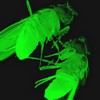 "But this imaging of insects, for all of its technical splendor, leaves the real mystery of scent unanswered. Using his neon neurons, Axel can look at the fly's brain and, with shocking accuracy, discern what smell the fly is smelling. He performs this act of mind reading by looking at the fly brain from the outside. But how does the fly know what it's experiencing? Unless you believe in a little drosophila ghost inside the fly machine, reconstructing its deconstructed smell, this mystery seems impossible to explain. As Axel notes, "No matter how high we get in the fly brain when we map this sensory circuit, the question remains: who in the fly brain is looking down? Who reads the olfactory map? This is our profound and basic problem."
~ Jonah Lehrer, Proust Was a Neuroscientist
"But this imaging of insects, for all of its technical splendor, leaves the real mystery of scent unanswered. Using his neon neurons, Axel can look at the fly's brain and, with shocking accuracy, discern what smell the fly is smelling. He performs this act of mind reading by looking at the fly brain from the outside. But how does the fly know what it's experiencing? Unless you believe in a little drosophila ghost inside the fly machine, reconstructing its deconstructed smell, this mystery seems impossible to explain. As Axel notes, "No matter how high we get in the fly brain when we map this sensory circuit, the question remains: who in the fly brain is looking down? Who reads the olfactory map? This is our profound and basic problem."
~ Jonah Lehrer, Proust Was a Neuroscientist
 Also see Peter Russell speaking on the mystery of consciousness, on the Favorite Video Clips page.
Also see Peter Russell speaking on the mystery of consciousness, on the Favorite Video Clips page.